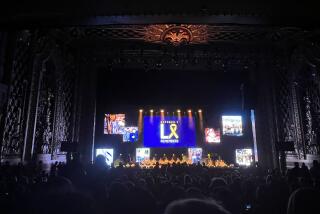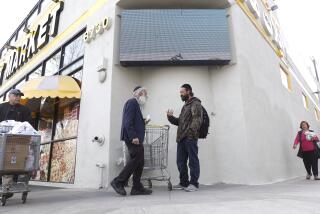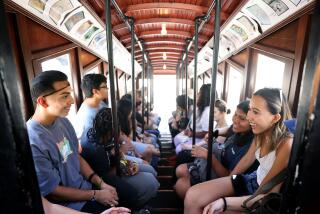Visit by Ethiopian Jews Prompts Talks on Bias : Education: The teen-age speakers, who immigrated to Israel to escape religious persecution, help Hollywood High students appreciate the similarities among people worldwide.
Last week at Hollywood High School, mounting tensions between Armenian and Latino students ended in fistfights and a visit from the Los Angeles Police Department.
This week, a visit from two Ethiopian teen-agers prompted students to discuss the discrimination, prejudice and communication barriers they face daily.
“Armenians and Hispanics fight, they don’t communicate, and you never see them together,” said Juan Pedraza, a 16-year-old immigrant from El Salvador.
“Here we have so many cultures, but sometimes you see only the differences in people,” said Caesar Garcia, 16, a Mexican immigrant. “Sometimes people don’t accept people the way they are, they don’t understand them. I always imagined (all) Jews as white people. Now, I have new friends from a place I didn’t even know existed.”
Orit Makonen, 17, and Reuven Zeleke, 18, who spent Wednesday and Thursday at Hollywood High, are two of eight black Ethiopian Jews brought here Nov. 7 by the Anti-Defamation League of B’nai B’rith. The students are meeting with Los Angeles teen-agers at 11 schools across the city.
Zeleke and Makonen are among 26,000 Ethiopian Jews who fled civil unrest in Addis Ababa, Ethiopia, and relocated to Israel. Makonen arrived during the airlift of Operation Moses in 1984, and Zeleke arrived on Operation Solomon in 1991.
Like many of the teen-agers at Hollywood High who emigrated with their families from their native countries, the Ethiopian students have faced prejudice and persecution.
Last year’s trip to Los Angeles by a different set of Ethiopian teen-agers was marred by the riots. This year’s visit is much calmer, but the goal of the program remains the same--to increase understanding and communication between ethnic groups, said Marjorie B. Green, league education director.
Hollywood High’s U.S. history teacher, David Payne, who also participated in last year’s program, said the visiting teen-agers helped expand the perspective of his students, the majority of whom are immigrants from Armenia and Latin America.
Payne said that after last year’s visit, students became more open-minded about racial issues.
“It’s a good forum to show how people are more similar than different,” he said. “When they talk to (the Ethiopians), they see how similar their stories are to these kids’ stories--the Latinos came here for financial reasons, or to escape civil war; the Armenians came because of religious persecution.”
As Makonen and Zeleke sat with Payne’s third-period history class, the American students shared their own stories about leaving their native countries.
“My parents came here for freedom and for opportunity,” said Marine Shirinian, 16, a junior who emigrated from Armenia in 1985. “They wanted a better life.”
Although many of Payne’s students traveled long distances under difficult conditions to this country, many gasped when Makonen described her monthlong journey by foot with her family from Ethiopia to Sudan.
“It was very difficult,” said Makonen, who traveled the 400 miles with her parents, grandparents and 6-month-old sister. “We had to travel only at night, because by day the government would catch us, and we would (have been) put in jail.”
Makonen and Zeleke agreed that the adjustment to a new culture was difficult, but they said that even though they are blacks among mostly white Jews, they have encountered no prejudice in Israel.
“It was difficult in Israel at first. I didn’t know the language or anything,” Makonen said. “But now, I am a sister of Israel--we are Jews, and it is good.”
More to Read
Sign up for Essential California
The most important California stories and recommendations in your inbox every morning.
You may occasionally receive promotional content from the Los Angeles Times.










